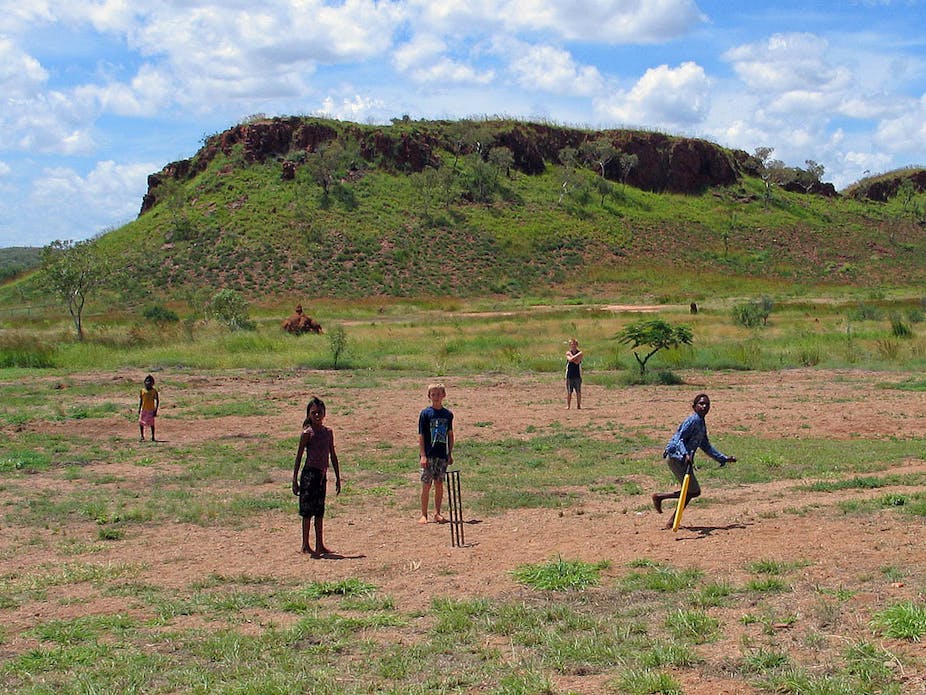Most remote Australian Indigenous communities have little or no access to digital technology. Last year, three internet-enabled terminals were installed as a trial in the remote communities of Burraluba Yuru Ngurra (Halls Creek WA), Binjari Top Camp (NT) and Bana Yarralji Bubu (Shiptons Flat QLD).
The terminals are robust, free standing units with vandal-resistant screens, keyboards and touchpads, designed to run 24/7 in the harshest conditions. Each has three screens and keyboards so several people can use them simultaneously. Educational games, books, and a child-friendly copy of Wikipedia were included as part of the content.
The trial ran from mid-November 2012 to April 30 2013 and demonstrated that the terminals are a valuable community resource, encouraging digital literacy in all three communities.
Usage data provided by the communities, electronic usage data and visits and observations confirm that:
community members have been able to interact with and use the terminals relatively easily
the terminals were well used by both children and adults. Both groups accessed a wide range of online and non-online content
children, not surprisingly, learned how to use the terminals very quickly and used them extensively for educational purposes
adults could do banking and buy goods online (this was previously impossible).
Where were the terminals installed?

All three communities were very positive and grateful that their community had been chosen for the trial. All think the terminal is an enormous asset for their community, helping community members in many different ways including educationally and socially.
Burraluba Yura Ngurra, Halls Creek (WA) The hostel, managed by the Wunan Foundation, is just outside Halls Creek and is a relatively small community. The terminal in this community was heavily used. The hostel manager and his wife introduced the adults to online banking and websites such as Seek.com. Some of the adults used Skype for communication. The women were encouraged to shop online and bought materials for sewing, the manager’s wife at the hostel has been using this activity to improve literacy.
The hostel manager reported that apart from using the internet, the children also read books and played games (those provided all have an education focus, supporting either numeracy or literacy). Children also used the terminal extensively for school work.
Binjari Top Camp (NT) This was the largest community, 20km from Katherine. People in this community used the terminal to watch YouTube videos uploaded by another community, and it encouraged them to be involved in different activities. Children used online educational materials and adults kept up to date on local news and weather.
Before this, there was no access to the internet and community members had minimal internet knowledge. The trial changed this.
Visitors from other communities used the terminal at this site. Children showed their parents how to use the terminal and are sharing with them the work they doing at school. It has helped build computer literacy among the adults. Community representatives expressed surprise at the positive impact this has had on their community.
Bana Yarralji Bubu (Shiptons Flat, Qld) Shipton’s Flat is near Cooktown. This is a small community. The children here find the terminal attractive, spending time using it after school. Adults mainly used it to process Centrelink requests, and look at educational websites, local news and weather forecasts. They also used Skype. One eight-year-old child said they thought it was the biggest change they had experienced in the community.
It is clear from this trial that installing robust computer terminals available 24/7 is of major benefit to Indigenous communities. Many locals now have better computer skills and a much greater awareness of computer technology as a result of the trial.
Robust terminals can and do support children’s education, developing skills they would not otherwise have.
They have significant potential for remote communities. Such technology can be used to support language and culture and offers opportunities for locally developed content.
This trial was funded by the Department of Broadband Communications and the Digital Economy (DBCDE) with assistance from Australian Private Network (APN) and researchers from the Faculty of IT at Monash University. The terminals were designed and developed by The Meraka Institute which is the ICT division of South Africa’s Council for Scientific and Industrial Research (CSIR).

